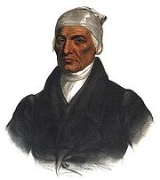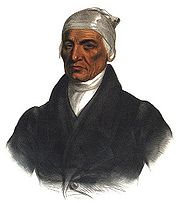
Black Hoof
Encyclopedia

Tribal chief
A tribal chief is the leader of a tribal society or chiefdom. Tribal societies with social stratification under a single leader emerged in the Neolithic period out of earlier tribal structures with little stratification, and they remained prevalent throughout the Iron Age.In the case of ...
of the Shawnee
Shawnee
The Shawnee, Shaawanwaki, Shaawanooki and Shaawanowi lenaweeki, are an Algonquian-speaking people native to North America. Historically they inhabited the areas of Ohio, Virginia, West Virginia, Western Maryland, Kentucky, Indiana, and Pennsylvania...
Indians
Native Americans in the United States
Native Americans in the United States are the indigenous peoples in North America within the boundaries of the present-day continental United States, parts of Alaska, and the island state of Hawaii. They are composed of numerous, distinct tribes, states, and ethnic groups, many of which survive as...
in the Ohio Country
Ohio Country
The Ohio Country was the name used in the 18th century for the regions of North America west of the Appalachian Mountains and in the region of the upper Ohio River south of Lake Erie...
of what became the United States
United States
The United States of America is a federal constitutional republic comprising fifty states and a federal district...
. A member of the Mekoche
Mekoche
Mekoche was the name of one of the five divisions of the Shawnee, a Native American people, during the 18th century. The other four divisions were the Chalahgawtha, Kispoko, Pekowi, and Hathawekela. Together these divisions formed the loose confederacy that was the Shawnee tribe....
division of the Shawnees, Black Hoof became known as a fierce warrior during the early wars between the Shawnee and Anglo-American colonists. Black Hoof claimed to have been present at the Battle of the Monongahela
Battle of the Monongahela
The Battle of the Monongahela, also known as the Battle of the Wilderness, took place on 9 July 1755, at the beginning of the French and Indian War, at Braddock's Field in what is now Braddock, Pennsylvania, east of Pittsburgh...
in 1755, when General Edward Braddock
Edward Braddock
General Edward Braddock was a British soldier and commander-in-chief for the 13 colonies during the actions at the start of the French and Indian War...
was defeated during the French and Indian War
French and Indian War
The French and Indian War is the common American name for the war between Great Britain and France in North America from 1754 to 1763. In 1756, the war erupted into the world-wide conflict known as the Seven Years' War and thus came to be regarded as the North American theater of that war...
, although there is no contemporary evidence that Shawnees took part in that battle.
Little documentary evidence of Black Hoof's life appears in the historical
History
History is the discovery, collection, organization, and presentation of information about past events. History can also mean the period of time after writing was invented. Scholars who write about history are called historians...
record before 1795. He probably took part in the Battle of Point Pleasant
Battle of Point Pleasant
The Battle of Point Pleasant, known as the Battle of Kanawha in some older accounts, was the only major battle of Dunmore's War. It was fought on October 10, 1774, primarily between Virginia militia and American Indians from the Shawnee and Mingo tribes...
during Lord Dunmore's War against the Virginia militia in 1774. During the American Revolutionary War
American Revolutionary War
The American Revolutionary War , the American War of Independence, or simply the Revolutionary War, began as a war between the Kingdom of Great Britain and thirteen British colonies in North America, and ended in a global war between several European great powers.The war was the result of the...
, he may have taken part in the siege of Boonesborough
Siege of Boonesborough
The Siege of Boonesborough took place in September 1778 during the American Revolutionary War. The attack on the Kentucky settlement of Boonesborough was led by Chief Blackfish, a Shawnee leader allied to the British. Months before the battle, Blackfish had captured and adopted Daniel Boone, the...
in 1778, which was led by Chief Blackfish
Chief Blackfish
Blackfish , known in his native tongue as Cot-ta-wa-ma-go or Mkah-day-way-may-qua, was a Native American leader, war chief of the Chillicothe division of the Shawnee tribe.-Biography:...
, as well as the subsequent defense of the Shawnee village
Village
A village is a clustered human settlement or community, larger than a hamlet with the population ranging from a few hundred to a few thousand , Though often located in rural areas, the term urban village is also applied to certain urban neighbourhoods, such as the West Village in Manhattan, New...
of Chillicothe
Chalahgawtha
Chalahgawtha was the name of one of the five divisions of the Shawnee, a Native American people, during the 18th century, as well as the name of the principal village of the division. The other four divisions were the Mekoche, Kispoko, Pekowi, and Hathawekela...
in 1779. In the Northwest Indian War
Northwest Indian War
The Northwest Indian War , also known as Little Turtle's War and by various other names, was a war fought between the United States and a confederation of numerous American Indian tribes for control of the Northwest Territory...
, Black Hoof was defeated by "Mad" Anthony Wayne
Anthony Wayne
Anthony Wayne was a United States Army general and statesman. Wayne adopted a military career at the outset of the American Revolutionary War, where his military exploits and fiery personality quickly earned him a promotion to the rank of brigadier general and the sobriquet of Mad Anthony.-Early...
and, following the collapse of the Indian confederation, surrendered
Surrender (military)
Surrender is when soldiers, nations or other combatants stop fighting and eventually become prisoners of war, either as individuals or when ordered to by their officers. A white flag is a common symbol of surrender, as is the gesture of raising one's hands empty and open above one's head.When the...
in 1795.
Like Little Turtle of the Miamis, Black Hoof decided that American Indians needed to adapt culturally to the ways of the whites in order to prevent decimation through warfare. During his later years, Black Hoof became an ally of the United States
United States
The United States of America is a federal constitutional republic comprising fifty states and a federal district...
and was responsible for keeping the majority of the Shawnee nation from joining "Tecumseh's War
Tecumseh's War
Tecumseh's War or Tecumseh's Rebellion are terms sometimes used to describe a conflict in the Old Northwest between the United States and an American Indian confederacy led by the Shawnee leader Tecumseh...
", which became part of the War of 1812
War of 1812
The War of 1812 was a military conflict fought between the forces of the United States of America and those of the British Empire. The Americans declared war in 1812 for several reasons, including trade restrictions because of Britain's ongoing war with France, impressment of American merchant...
.
Black Hoof resisted the policy of Indian removal
Indian Removal
Indian removal was a nineteenth century policy of the government of the United States to relocate Native American tribes living east of the Mississippi River to lands west of the river...
that the United States implemented soon after the War of 1812. He never signed a removal treaty
Treaty
A treaty is an express agreement under international law entered into by actors in international law, namely sovereign states and international organizations. A treaty may also be known as an agreement, protocol, covenant, convention or exchange of letters, among other terms...
, and continued to lead his tribe until his death in Saint Johns, Ohio
Saint Johns, Ohio
Saint Johns is a census-designated place located along the border between the Union and Clay Townships of Auglaize County, Ohio, United States.It is located between Indian Lake and Wapakoneta at the intersection of U.S. Route 33 and State Route 65...
in 1831. After his death, the Shawnee were eventually compelled to emigrate
Emigration
Emigration is the act of leaving one's country or region to settle in another. It is the same as immigration but from the perspective of the country of origin. Human movement before the establishment of political boundaries or within one state is termed migration. There are many reasons why people...
to the West.

